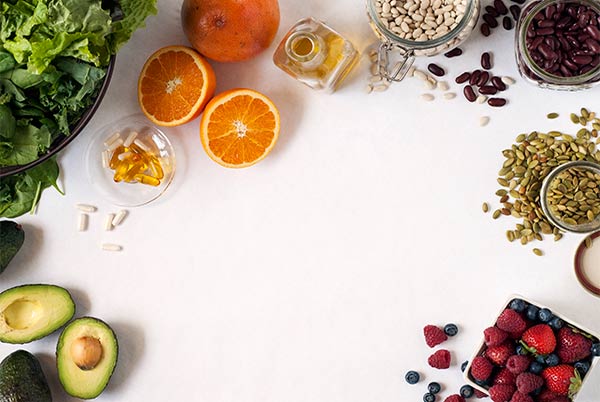
Food & Supplements for Healing
With the advent of a new year, there’s a good chance you’re feeling inspired to make 2014 the year of getting healthier. If so, you’re in the right place! Whether you have celiac disease, gluten sensitivity, or are just trying to optimize gut health, the plan that follows is for you. You’ll not only learn what to eat, but also what supplements aid in healing a damaged, leaky, or inflamed small intestine.
Let’s start with a healthy diet. The food portion of the plan focuses on the “macronutrients” (large amount of nutrition), as opposed to the “micronutrients” (small amounts of nutrition) that one receives from supplements. Patients sometimes ask me if it’s okay to just take vitamins while continuing to eat whatever they want. It’s a nice thought, but not one that’s going to get the job done. There is no way that a standard American diet (SAD) with its over-processed, low nutrient, chemical-laden “food” can provide you with adequate nutrition to improve your health, even if you’re taking the best vitamins. The simple truth is that you’re going to have to make some changes in what you eat.
What to Eat
1. Nine servings of organic fruits and vegetables per day.
I like this to be a bit heavier on the vegetables, so a ratio of 5/4 or 6/3 is ideal. One serving of “hard” veggies such as zucchini or broccoli is ½ cup. One serving of leafy veggies like kale or Swiss chard is one cup. Not only are veggies and fruits loaded with antioxidants that are helpful with healing, but they are also anti-inflammatory and act as prebiotics to the probiotic population in the gut. Some of the best choices are kale, collard greens, bok choy, broccoli, cauliflower, asparagus, spinach, chard, and Brussels sprouts. In the fruit category, enjoy blueberries, blackberries, raspberries, cherries, and citrus. A serving of fruit is ½ cup. Try to incorporate at least one to two servings of these high-nutrient fruits each day, while not exceeding a single serving of such fruits as apples, pears, plums, peaches, nectarines, and bananas, because these fruits are higher in sugar.
2. Nuts and seeds. Enjoy them in their fresh, raw state (not fried or salted). Some of the best nut choices are almonds, pecans, macadamia nuts, hazelnuts, and walnuts. Seeds, like nuts, are full of protein, good fat, vitamins, minerals, and fiber. Enjoy seeds such as chia, flax, pumpkin, sesame, and sunflower.
3. Monounsaturated fats. These fats are particularly healthful and found in two of my favorite foods: avocados and olives. You’ll also find them in extra-virgin olive oil. (Just remember to only cook with olive oil up to medium temperatures.) Olive oil has anti-inflammatory properties as well as healing phytonutrients.
4. Oils. As mentioned above, olive oil is wonderful unless you need to raise the heat when cooking (as in stir frying). When that is the case, coconut oil is a smart choice. It’s stable at high heat and actually aids in weight loss in addition to being anti-inflammatory. If you dislike the flavor of coconut, try some other healthy oils such as avocado, walnut, and sesame. Try to find these in their unprocessed cold-pressed versions. Why cold-pressed? Sadly, the processing of oil using high heat removes much of the nutrients. The oil is stable in that it won’t go rancid, but it’s no longer going to provide you with helpful nutrition. Oils to avoid include soy, corn, canola, safflower, and sunflower. These are fragile and easily break down unless they’re highly processed. They’re also high in omega-6 fatty acids, which are inflammation-producing oils.
5. Beans and legumes. Inexpensive and a great source of protein, fiber, vitamins, and minerals, beans and legumes offer plenty of potential for creating a variety of flavorful dishes. Lentils, pinto beans, adzuki beans, garbanzo beans, cannellini beans, black beans, and more are a great source of phytonutrients.
6. Animal protein. Keep this to a minimum and make sure that what you do eat is free of hormones, antibiotics, pesticides, and heavy metals while being free-range, cage-free, or wild (in the case of fish). Since restaurants typically do not serve these high quality types of animal products, consider eating animal protein only at home when you know what you’re getting in terms of quality. The hormones, chemicals, drugs, and poor diet given to most animals in the US makes them, in the main, an unhealthy choice for those who are trying to rebuild their digestive tract and immune system. With that said, it is possible to find sources of high quality animal protein. Eggs are one of the easiest proteins to find in good “clean” form. Seek out eggs from cage-free hens that have been fed omega-3fatty acids and no antibiotics.
How to Supplement a Healthy Diet
When it comes to supplements, there are two major categories of nutrients to address. The first is to augment those nutrients that are commonly found deficient in those with celiac disease. Second are those nutrients required to heal the damage to the gut (leaky gut) and rebuild the immune system.
The common deficiencies for those with celiac disease include vitamins A, K, D, and B12, along with the minerals calcium, magnesium, iron, and zinc. The fatigue, pain, and weak immune system so commonly linked with celiac disease can be directly related to deficiencies of one or more of these nutrients. It is an excellent idea to see your doctor and ensure that your levels are normal and then supplement as needed.
Healing a leaky gut is a critical part of regaining your health.
When it comes to normalizing your immune system to better defend you from infection, not to mention auto-immune disease, there is nothing more important than healing the 23 feet of tissue that comprises your small intestine.
Several herbs and nutrients in particular are very helpful in healing. These include L-glutamine, DGL (deglycerized licorice), aloe, siberian ginseng, hawthorne, milk thistle, slippery elm bark, quercitin, glucosamine, bromelain, gamma oryzanol, vitamin D, and probiotics. Fish oil and turmeric are both excellent for their anti-inflammatory properties, which are important for not only healing the lining of the intestine, but also in the prevention of degenerative disease.
While that’s a pretty long list, there are products that contain the first 11 substances in one capsule. There seems to be a synergy that takes place when these nutrients are taken together, not to mention that it’s definitely easier to take one or two capsules than a handful of 11 different pills!
Vitamin D, you may have noticed, is both commonly deficient in those with celiac disease and is needed for healing as well. Fortunately, a blood test for this is readily available and therefore makes it easy to monitor improvement. Ensure that you take the D3 version of the vitamin, preferably in a base of fat for best absorption.
Digestive enzymes are also helpful. There’s an interesting “catch-22” that occurs with enzymes. You need to digest food in order to make adequate amounts of enzymes, while at the same time enzymes allow you to digest your food. Therefore, those with gluten intolerance who have had compromised digestion often experience deficiency in enzymes with resultant poor absorption. My favorite enzyme product contains hydrochloric acid to enhance stomach digestion in addition to pancreatic enzymes. Both facets of digestion are addressed, again in just one capsule.
I’m often asked what type of probiotics to take. There is much research occurring in this field and more is needed. When you consider that over100 trillion organisms make up the microbiome or probiotic population of the gut, and that this colony of organisms—when healthy—is able to keep bad genes (those that create diseases) turned off, you begin to appreciate the importance of keeping the gut environment healthy. To date, the best we know is that human strains are most ideal along with a variety of organisms such as lactobacillus and bifidus. As far as amounts, the capsules I use have 20 billion CFU (colony forming units) and I typically recommend 2/day.
The Secondary Effects of Gluten
Now that we’ve discussed what to eat and what vitamins to take, there’s one last point that must be made: What if doing all this doesn’t make you feel better?
That’s a big one and, sadly, one I hear all too often. While the nutrition and supplement plan is solid and backed by research, it’s predicated on the body’s ability to utilize that good food and those pricey supplements. If your body is so overwhelmed, overtaxed, and inflamed that it’s unable to put those nutrients to good use, all is for naught. Why does that happen? The reason is something I call the Secondary Effects of Gluten.
Many celiac sufferers are told that time and a gluten-free diet will heal all their problems. If that is the case, then why did a study in Alimentary Pharmacology and Therapeutics show that “50% of the adult celiac patients carefully treated with a gluten-free diet for several years, showed signs of poor vitamin status”? The truth is that time and gluten-free isn’t adequate. We see this with patients all the time. They feel better but not great. The Secondary Effects of Gluten must be addressed. They are:
1. Infections
2. Cross-reactive foods
3. Other food sensitivities (dairy is most common) SGF
4. Nutrient deficiencies
5. Probiotic imbalance
6. Enzyme deficiencies
7. Hormonal imbalance
8. Presence of toxins
I mentioned one of these effects in a prior article on cross-reactive foods (“Cross Reactive Foods,” July/August 2013). These are foods that do not contain gluten, but their protein structure is so similar that an overburdened immune system is confused into thinking they are gluten, and so the body reacts in the same way it does when eating gluten. That can be pretty confusing, not to mention frustrating, when you’re trying so hard to remain gluten-free.
Another major aspect of the Secondary Effects that I’d like to highlight is hidden infection. Bacteria, amoeba, or parasites are true infections that reside in the intestine and wreak havoc on the body. They can cause a leaky gut to persist, while creating inflammation and continuing to weaken the immune system. These infectious organisms can initiate autoimmune disease and create the likelihood formal-absorption and further food reactions. They are not your friend and in order to determine if you have one, you need to be tested. If left untreated, these infectious organisms can truly ruin the best nutritional efforts.
I’m not affiliated with any labs and I receive no compensation for recommending one over another, but when it comes to this type of testing there are some labs that are quite a bit better than others. We use a lab called Genova because they get the job done. If you get tested, you’ll need to work with a doctor who is well acquainted with how best to deal with any infections that are discovered. If you need assistance finding a clinician to help you, feel free to contact me. I’m here to help! As always, remember to seek the advice of a medical professional before beginning any new protocol.
To your good health,
Dr Vikki Petersen, DC, CCN
ABOUT THE AUTHOR:
Dr. Vikki Petersen, winner of the “Gluten-Free Doctor of the Year” award, is a Doctor of Chiropractic, Certified Clinical Nutritionist, internationally published author, speaker, and co-founder of Root Cause Medical Clinic. She is the author of The Gluten Effect, a best-seller on gluten sensitivity and celiac disease.



